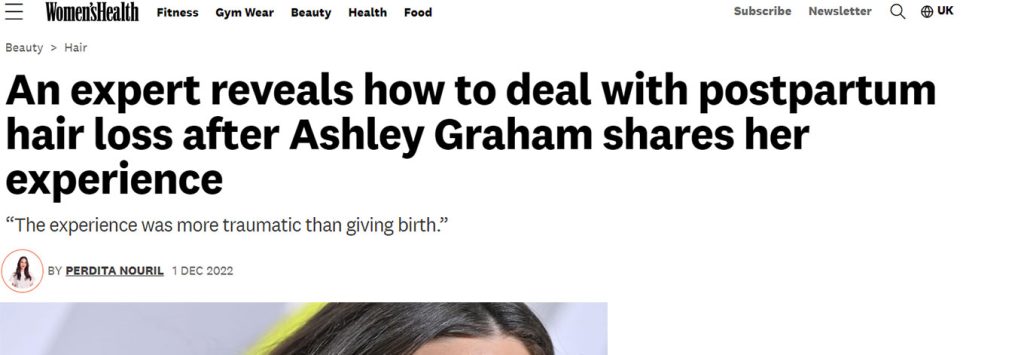
An expert reveals how to deal with postpartum hair loss after Ashley Graham shares her experience
FEMALE HAIR LOSS
‘New mum hair’ is probably waaay down on the list of things you’re thinking about once you’ve got your new babe in arms and yet postpartum hair loss is believed to affect up to 50 percent of women following the birth of their child. It’s a condition Ashley Graham knows all too well and the star has been documenting her struggle with the condition via her instagram.
[…]
Women’s Health spoke to leading hair loss specialist and hair transplant surgeon at The Private Clinic, who explains all you need to know about how to deal with postpartum hair loss.
What is postpartum hair loss?
‘Postpartum hair loss is also known as postpartum alopecia or telogen effluvium and affects a significant proportion of women who have given birth. It usually occurs about three months after childbirth and can last up to six months. Women may experience their hair being thinner or noticing more hair falling out either when brushing or in the shower. The condition is usually temporary and is likely to rectify itself within a year, although some of my patients feel that their hair is noticeably thinner for a longer period,’ says The Private Clinic
What causes postpartum hair loss?
‘Hormone levels change during pregnancy, particularly in the last trimester an increase in Oestrogen levels reduces hair shedding so women often notice that their hair is thicker and healthier before giving birth. The drop in Oestrogen post-partum can lead to an increase in the amount of shedding and thinning of hair,’ they add.
How do you treat postpartum hair loss?
‘Usually, postpartum hair loss is nothing to worry about and your hair is likely to return to normal thickness after a few months, however there are several things that you can do to encourage healthy hair growth,’ says The Private Clinic. Here are their top tips.
1/ Avoid tight hair styles
‘Pulling the hair back tightly can put considerable strain on the hair follicles, over a prolonged period it can cause what we refer to as traction loss where these strained follicles eventually fall out.’ Read more on Traction Alopecia here.
2/ Don’t use dry shampoo too often
‘Unlike conventional shampoos that clean the hair, dry shampoos include ingredients that absorb grease and make hair look cleaner. Whilst using them occasionally isn’t likely to cause too much damage, using them regularly can lead to damage and potential breakage, or in severe cases hair thinning.’
‘Propane and Butane are common in many aerosols, including dry shampoos. However whilst with other products they don’t come into contact with the skin for a long period of time, dry shampoo is designed to sit around the root of the hair potentially damaging the hair follicle and impacting growth.’
‘Providing you only use dry shampoos occasionally they shouldn’t prove to be a problem. However, for optimum hair health we would advise people to avoid using them every day.’
3/ Take vitamin supplements
‘Health and nutrition is an important factor in healthy hair growth, many of us lack essential vitamins and minerals because we don’t get enough of them in our diet and so vitamin supplements can be a good way of ensuring you’re getting the necessary micronutrients that are essential for hair growth.’
‘It is important however to recognise that these should be tailored to your specific needs, for example, if you are experiencing post-partum hair loss then the vitamins you will need are likely to be different to someone who is experiencing hair loss due to a dietary deficiency. Also, whilst supplements can help to improve the quality and thickness of your hair, it’s important not to expect a miracle transformation.’
4/ Look into treatments
‘A non surgical hair loss treatment for the scalp works by taking a small amount of blood, separating this blood in a centrifuge before injecting back into scalp.’
‘The plasma contains stem cells and growth factors which are separated from your blood and injected into the scalp. The growth factors can then stimulate the activity of the hair follicles and promote hair growth in areas of thinning or loss.
‘It takes a matter of minutes to take blood and then around 10 minutes to spin it in the centrifuge to facilitate the separation. Afterwards there’s no significant downtime and my patients can return to normal activity. We expect to see a response from 6 weeks after the initial treatment with patients usually describing thicker and better quality hair.’
Find out more about Female Hair Loss here
Our team of hair transplant surgeons and hair loss specialists can help assess your hair loss and advise on the best course of treatment to help reduce hair loss and eventually restore areas of thinning or balding.
As a multi-award-winning hair loss practice, we have been specialising in the most innovative hair loss and hair regrowth treatments for over 40 years.
We make it easy for you to discuss your hair loss concerns with our expert clinical hair loss specialists.
Patients have given us a 96% patient satisfaction rating, and we have a 5-Star Trustpilot rating which showcases our high standards and our dedication to high standards of patient care.
To find out more about our hair loss strategies, fill out our online enquiry form. You can also call us on 0333 920 2471.




